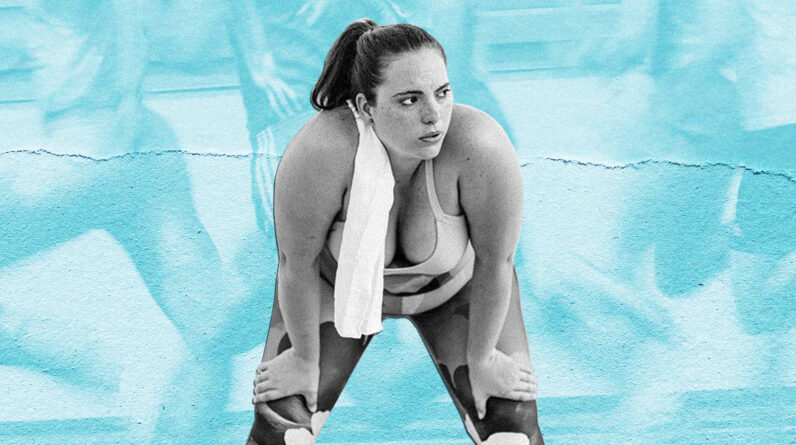
You’ve seen the pictures: The ones where a runner is covered in their own feces, struggling through the end of a race. Maybe your marathon-running bestie has war stories of barely making it to the porta-potty—or not making it all. But runner’s trots are normal, right? Well, no. It turns out runner’s diarrhea is not a foregone conclusion to logging miles.
If you have runner’s diarrhea, something needs to change. Soiled shorts are not a badge of running honor. It’s actually improper fueling and dehydration that may lead to unfortunate bowel emergencies. And yep, it’s mostly preventable.
We chatted with two sports dietitians who specialize in the field of running and nutrition to get the inside info on why running can give you the runs, and how to keep it from happening.
Is diarrhea while running normal?
If running is clearing more than your mind, you aren’t alone. Kylee Van Horn, RDN, of Flynutrition works with endurance athletes looking to hit PRs and improve overall health— including complex gut issues.
“Some runners may experience something called ischemic colitis when running, but many runners could experience diarrhea and have it caused by their nutrition before, during, or in everyday life,” she explains.
Ischemic colitis is caused by blood flow being directed away from the colon to the muscles. But that’s not necessarily the reason for your runner’s trots, and ischemic colitis is much more common1 for ultrarunners than recreational runners.
So what is it about running that gets the bowels moving? “The ‘why’ is not always easy to pinpoint. According to Van Horn, other causes could include:
Indeed, under-fueling is one of the biggest culprits Van Horn sees over and over.
All that to say, pooping your pants isn’t a sign that you’ve hit a magical training goal. It could be a serious gut issue…or improper nutrition.
Rather than accepting it as a normal part of running, getting to the “bottom” of it is a good idea. If you choose races by how many porta-potties are on the route, consider evaluating your nutrition and gut health. Van Horn explains what that looks like:
- To start, ensuring you don’t have any underlying gut abnormalities
- Dialing in hydration and electrolyte strategies pre- and during exercise
- Ensuring that your fueling plan is built and tested before race day and that you vary carbohydrate types during exercise
- Understand what ‘eating enough’ as a runner looks like
- Reducing fiber, fat, and protein pre-run
But why do so many runners act like runner’s diarrhea is just a normal part of the sport? When you meet a fellow runner, it’s an instant friendship. You talk about our long runs, races, and mishaps—including gastro mishaps. It’s almost like a point of pride.
“I think people just have heard stories about ‘pushing themselves’ physically to their limits, and they assume pooping your pants is included in that,” Van Horn says. But losing control of your bowels should not be the goal.
How can you prevent runner’s diarrhea?
Fortunately, some tweaks in your nutrition plan may prevent your race day bathroom breaks. But it isn’t an overnight fix. Fueling your runs requires intention.
“Just as you train for a race, you have to also train your gut to accept food!” says Roxana Ehsani, MS, RD, CSSD, LDN, a registered dietitian nutritionist and board-certified sports dietitian who has worked with many professional, Olympic, collegiate, and high school teams and athletes. “It requires practice.”
While these tips will hopefully have you hitting your PR, not the toilet, if diarrhea persists, be sure to talk to your doctor.
Here’s how to get started:
During a run
Sure, most races offer gels and chews along the way, but if it’s your first time with that product, you’re taking a risk.
“Don’t go out on race day downing a few energy gels and expect your stomach to be able to tolerate them without practice,” says Ehsani.
How can you train your gut2 for mid-workout fuel? Ehsani recommends starting slowly.
“Begin by having a sports drink as your workout fuel. Sports drinks are easy to tolerate and provide easy-to-digest carbs, electrolytes, and fluid,” she says. “Once you’ve managed to tolerate sports drinks without issues during your training runs, try solid food such as a sports gel, GU, or jelly beans.”
Yep, jelly beans: These are made primarily of quick-to-digest carbs, so they should be easy to tolerate. Start with half a serving (that’s about 20g, or 18 jelly beans) and make your way up to a full serving.
Before a run
It’s tempting to skip breakfast to avoid a bathroom emergency, but underfueling isn’t the answer. Instead, Ehsani suggests training your gut for pre-run nutrition as well.
“Follow the same method: Start with a sports drink, then test out a sports food like energy gels, then work your way up to a whole food, such as a granola bar or piece of fruit like banana or dried fruit like raisins.”
Choose easily digested foods
What and when you eat matters.
“Timing is everything and so is the food you choose. Don’t have a full-blown meal, such as a grain bowl an hour before your run,” Ehsani says.
She recommends having your last meal 3 to 4 hours prior to the start of a run and having an easy-to-tolerate snack 1 to 2 hours before your run. This snack should be low-fat, low-fiber and low in protein. It should strictly be easy to tolerate carbs: as a piece of fruit, a handful of pretzels, crackers, or a few energy chews.
And while fiber and protein are essentials in the diet, you don’t want them right before a run.
“Avoid anything fibrous, rich in fat, or high in protein as these foods take a lot longer for your gut to break down and digest,” she says.
Hydrate, hydrate, hydrate
Finally, proper hydration is key to gut health. Ehsani recommends hydrating all day, rather than just before a run.
“If you gulp down cups and cups of fluid right before your run, that will likely upset your stomach,” she says. “To be well-hydrated during your run, be sure to keep a water bottle or glass nearby and sip from it all day.”
Well+Good articles reference scientific, reliable, recent, robust studies to back up the information we share. You can trust us along your wellness journey.
- Ho, Garry W K. “Lower gastrointestinal distress in endurance athletes.” Current sports medicine reports vol. 8,2 (2009): 85-91. doi:10.1249/JSR.0b013e31819d6b7b
- Tiller, Nicholas B et al. “International Society of Sports Nutrition Position Stand: nutritional considerations for single-stage ultra-marathon training and racing.” Journal of the International Society of Sports Nutrition vol. 16,1 50. 7 Nov. 2019, doi:10.1186/s12970-019-0312-9







